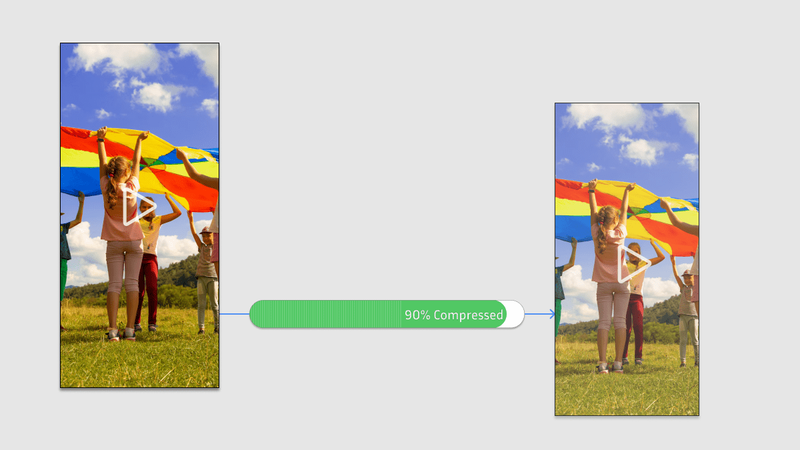What is a Video Processing API?
A Video Processing API is an application programming interface (API) that provides developers with tools and functions to process videos programmatically. It allows developers to integrate video processing capabilities into their own applications, systems, or websites without having to build the video processing logic from scratch.
To be a bit more specific, video processing APIs allow developers to automate various video-related tasks such as video encoding, video decoding, video editing, video resizing, video watermarking, and extracting video metadata from video files.
There are 5 types of video processing APIs: Video Preview APIs, Video Encoding APIs, Video Decoding APIs, and Video Manipulation APIs.
- Video Preview API
- Video Encoding API
- Video Storage API
- Video Decoding API:
- Video Manipulation API
Video Preview APIs
Video Preview APIs allow applications to integrate functionality for users to play and review video content without leaving the page. A Video Preview API typically generates a preview or thumbnail of the current video.
ApyHub APIs allow the developer to generate an image or video thumbnail from any part of the given video file or URL.
Example of Generating Video Thumbnails in Fusion API Client
Video Encoding APIs
Video Encoding APIs allow developers to encode and process videos programmatically. The API converts video files into different formats, resolutions, and bitrates, making them compatible with various devices and platforms.
ApyHub's Video Encoding APIs allow developers to compress and convert a video to 7 different formats including .MP4, .WEBM .FLV .AVI, .MKV, .MOV, and .3GP
An example of video compression by 90%.
Video Storage APIs
Video storage APIs provide a way for developers to easily integrate video functionalities into their products without the need to build and maintain their server infrastructure for encoding, hosting, and delivering videos.
This api.video’s Video Storage API streamlines the entire video process, from encoding to storage, and delivery.
Video Decoding APIs
The Video Decoding API provides developers the capability to perform various operations on videos, enhancing their functionality and visual appeal. With this powerful tool, developers can seamlessly integrate watermarking functionality into their applications, allowing for brand recognition and copyright protection.
ApyHub’s Generate GIF from Video API lets developers generate animated GIFs and Video watermark API allows for watermarking videos using text or images.
Example of an Image and Text Watermark added to the video.
Video Manipulation API
Video Manipulation APIs provide developers with the capability to perform various operations on videos, including extracting useful information such as metadata, transcripts, and audio. These APIs offer a range of functionalities that enable developers to access and manipulate different aspects of videos programmatically.
ApyHub’s Extract Video Metadata API allows developers to fetch metadata from any video file or URL. This includes details like file properties and video specifications. While, extracting audio from a video API allows converting video to mp3 and other popular formats like WAV, AAC, OGG, FLAC, and more.
How To Choose The Right Video API?
Begin by evaluating the application's specific requirements, such as live streaming, recording, playback, or video conferencing. Prioritize scalability to accommodate fluctuating levels of traffic and demand. Additionally, verify that the API has some robust security features including encryption and access controls.
Integration simplicity is vital, so opt for an API with thorough documentation, well-supported SDKs, and user-friendly interfaces that seamlessly merge with the current infrastructure. Cross-platform compatibility is key for broad accessibility; therefore, choose an API that caters to various devices and operating systems.
Consider pricing structures aligned with the budget and usage habits, along with available support options and user feedback. Transparent pricing and responsive customer service can significantly ease integration and troubleshooting. Additionally, evaluate the API's scalability, ensuring it can handle application's growth and changing needs effectively.
Consider the expected growth of the product and the potential increase in video traffic. Opt for an API that can handle the expected load and scale seamlessly as the product expands.
Finally, ensure the API offers robust security features such as end-to-end encryption and complies with privacy regulations such as GDPR. Users' data must always be protected, so choosing an API that prioritizes security and compliance is essential.
Conclusion
Video Processing APIs are excellent utilities for adding functionalities like encoding, decoding, editing, and watermarking to existing applications. This not only saves important time and money but also allows businesses to be more productive while reducing the time to market an application.












Top comments (17)
Thank you for sharing your experience. Removing a watermark also signals originality. If you’re using your own footage, a clean video shows that you own the content and have full rights to it. This builds trust with your audience and potential clients. It demonstrates that you produce authentic material rather than repurposing someone else’s. I usually use this tiktok watermark remover. In a competitive media space, originality is key to standing out.
Among the top video processing APIs in 2024, Wink stands out as a reliable and versatile solution for creators and developers alike. It offers advanced editing capabilities such as background removal, watermark removal, and high-quality video enhancements, making it especially valuable for businesses that need professional results without complex integrations.
Other leading options include ApyHub’s Video Encoding API for compression and format conversion, api.video’s Storage API for seamless hosting and delivery, and Fusion’s Preview API for generating thumbnails and previews. Together, these APIs cover a broad spectrum of video processing needs, from encoding and decoding to metadata extraction and watermarking.
For those seeking a practical, ready-to-use editing solution beyond traditional APIs, winkapkz.com/
provides access to Wink’s powerful editing features in an accessible way, eliminating the need to build video processing logic from the ground up.
This post is super helpful for anyone who edits videos. It shows the best tools to make videos faster and better in 2024. Great list for beginners and pros!
I'm looking to cut some videos and want to do it all online without having to download software. I've tried a couple of tools already, but I'd love some recommendations on the best ones out there.
Do you have any favorites that are easy to use and don’t add watermarks? What about this cortar video online tool? Also, what are the limits with free versions in terms of video length or quality? And are there any tools that keep the video quality intact after cutting?
Thanks for sharing this helpful info about the Top Video Processing APIs. It’s a great guide for anyone who works with videos. These APIs help developers do things like resize videos, add watermarks, change formats, or even pull out audio or thumbnails, without writing all the code from scratch. It saves a lot of time and effort, especially for web or app developers.
To keep this useful guide safe and easy to find later, make sure to store it in your Terabox space platform. That way, you can open it anytime you need it, from any device.
A Video Processing API is a set of tools developers use to automate and integrate video editing and handling features into their apps, websites, or platforms. Instead of building everything from scratch, developers can use these APIs for tasks like video encoding, resizing, watermarking, metadata extraction, and more.
There are several categories of these APIs, including:
Video Preview APIs – for generating thumbnails and playback previews
Encoding APIs – to compress or convert video formats
Decoding APIs – like turning videos into GIFs or adding watermarks
Manipulation APIs – for editing, trimming, or extracting audio and metadata
These APIs power many video apps behind the scenes — but on the front end, they enable intuitive tools like the Wink Editor for iPhone/iOS. Wink is a sleek, easy-to-use editing app designed for iPhone users, offering essential editing features like trimming, adding transitions, music overlays, and exporting in high quality. While users enjoy a smooth editing experience, it’s tech like video processing APIs working quietly in the background that makes it all possible.
Whether you're a developer or a creator, understanding how these APIs work — and the apps that rely on them — can give you a clearer view of what’s happening under the hood.
Video Processing APIs are invaluable for developers aiming to streamline video-related tasks efficiently without starting from scratch. They facilitate encoding, decoding, and even watermarking, providing comprehensive tools for enhancing video applications. The ability to handle everything from compression to format conversion makes these APIs a vital resource for maintaining high-quality video standards across devices and platforms. On a related note, if you're looking to enhance your audio experience while working on video projects, Spotify APK offers seamless, ad-free music streaming, ensuring uninterrupted creative flow and a vast library to suit any mood or project theme.
This overview of video processing APIs is really insightful for developers looking to add robust video features quickly without reinventing the wheel. It’s impressive how these APIs can handle everything from encoding and thumbnail generation to watermarking and extracting metadata, making video workflows so much more efficient. Choosing the right API definitely depends on your project’s needs, scalability, and security requirements. And if you’re just looking for a reliable way to watch great content, loklok mod apk is a fantastic pick, it truly excels as one of the best streaming apps for movies, TV shows, and series.
Excellent breakdown of the top video processing APIs for 2024! Understanding the different types and their specific applications can really help developers choose the right tools for their projects. Additionally, if you're looking for a diverse range of apps to complement your video development work, the Scarlet iOS app is a fantastic alternative to the Apple App Store. It provides access to a wide array of applications that can enhance your video processing and development experience seamlessly.
This list of top video processing APIs for 2024 is incredibly helpful for developers and creators looking to enhance their projects with cutting-edge tools. APIs are essential for building scalable and efficient applications, especially in areas like video editing, streaming, and content creation.
For those who prefer an all-in-one solution for video editing, platforms like winkapkgeek.com/ are worth exploring. It provides access to a powerful video editing app that is user-friendly and equipped with features to simplify workflows. Whether you’re a developer experimenting with video APIs or a content creator working on polished visuals, combining reliable APIs with accessible editing tools can significantly boost productivity and creativity.
Having access to diverse resources like APIs and video editing platforms allows developers to streamline their projects and deliver professional-grade results. Platforms like Winkapkgeek are an excellent complement to the APIs mentioned in the article, offering flexibility and efficiency for all kinds of video-related tasks.
Some comments may only be visible to logged-in visitors. Sign in to view all comments.